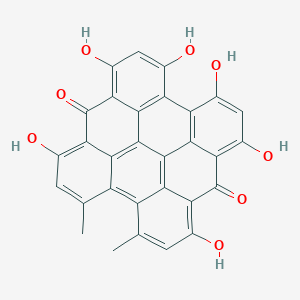hypericin
hypericin is a lipid of Polyketides (PK) class. Hypericin is associated with abnormalities such as Dermatitis, Phototoxic, Dehydration, Photosensitization, Morphologically altered structure and Myocardial Infarction. The involved functions are known as Cell Cycle Checkpoints, Apoptosis, Acetylation, Cell Survival and Caspase Activation. Hypericin often locates in insoluble fraction, Cytoplasmic matrix, Protoplasm, Tissue membrane and Cytoplasm. The associated genes with hypericin are CDC37 gene, HSPA8 gene, RAF1 gene, cyclin H and FK228. The related lipids are Phosphatidylserines.
Cross Reference
Introduction
To understand associated biological information of hypericin, we collected biological information of abnormalities, associated pathways, cellular/molecular locations, biological functions, related genes/proteins, lipids and common seen animal/experimental models with organized paragraphs from literatures.
What diseases are associated with hypericin?
hypericin is suspected in Dermatitis, Phototoxic, Photosensitization, Pneumonia, Psoriasis, Phototoxicity, Chronic infectious disease and other diseases in descending order of the highest number of associated sentences.
Related references are mostly published in these journals:
| Disease | Cross reference | Weighted score | Related literature |
|---|
Possible diseases from mapped MeSH terms on references
We collected disease MeSH terms mapped to the references associated with hypericin
PubChem Associated disorders and diseases
What pathways are associated with hypericin
There are no associated biomedical information in the current reference collection.
PubChem Biomolecular Interactions and Pathways
Link to PubChem Biomolecular Interactions and PathwaysWhat cellular locations are associated with hypericin?
Visualization in cellular structure
Associated locations are in red color. Not associated locations are in black.
Related references are published most in these journals:
| Location | Cross reference | Weighted score | Related literatures |
|---|
What functions are associated with hypericin?
Related references are published most in these journals:
| Function | Cross reference | Weighted score | Related literatures |
|---|
What lipids are associated with hypericin?
Related references are published most in these journals:
| Lipid concept | Cross reference | Weighted score | Related literatures |
|---|
What genes are associated with hypericin?
Related references are published most in these journals:
| Gene | Cross reference | Weighted score | Related literatures |
|---|
What common seen animal models are associated with hypericin?
There are no associated biomedical information in the current reference collection.
NCBI Entrez Crosslinks
All references with hypericin
Download all related citations| Authors | Title | Published | Journal | PubMed Link |
|---|---|---|---|---|
| Rayburn WF et al. | Impact of hypericum (St.-John's-wort) given prenatally on cognition of mice offspring. | Neurotoxicol Teratol | pmid:11792531 | |
| Li ZH et al. | Hypericin damages the ectatic capillaries in a Roman cockscomb model and inhibits the growth of human endothelial cells more potently than hematoporphyrin does through induction of apoptosis. | Photochem. Photobiol. | pmid:25065502 | |
| Jiang C et al. | Hypericin as a marker for determination of myocardial viability in a rat model of myocardial infarction. | Photochem. Photobiol. | pmid:24460608 | |
| StaniÄová J et al. | Potential anticancer agent hypericin and its model compound emodin: interaction with DNA. | Ceska Slov Farm | pmid:27118502 | |
| Skyba M et al. | Physiological, biochemical and molecular characteristics of cryopreserved Hypericum perforatum L. shoot tips. | Cryo Letters | pmid:20919454 | |
| Bancirova M and Lasovský J | The photodynamic effect: the comparison of chemiexcitation by luminol and phthalhydrazide. | Luminescence | pmid:20853519 | |
| Lavie G et al. | "Competitive quenching": a mechanism by which perihydroxylated perylenequinone photosensitizers can prevent adverse phototoxic damage caused by verteporfin during photodynamic therapy. | Photochem. Photobiol. | pmid:17880523 | |
| Lobban CS et al. | Photophysics and multifunctionality of hypericin-like pigments in heterotrich ciliates: a phylogenetic perspective. | Photochem. Photobiol. | pmid:17880503 | |
| Kanofsky JR and Sima PD | Structural requirements for efficient cellular photoprotection by carotenoid derivatives. | Photochem. Photobiol. | pmid:15623338 | |
| Bragin DE et al. | Photodynamic inactivation of isolated crayfish neuron requires protein kinase C, PI 3-kinase and Ca2+. | J. Photochem. Photobiol. B, Biol. | pmid:12849700 |
